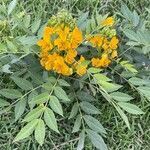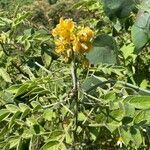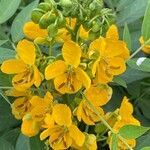Shrub or suffrutescent herb 0.5-2 m tall. Stems, leaves, and inflorescence axis glabrous or more often hirsute with straight, lustrous hairs. Stipules linear, persistent at anthesis. Leaves 10-30 cm long, the petiole 2-8(-10) cm long, bearing a conic or claviform nectary at its base; leaflets 4-6 pairs, elliptic to obovate, the terminal pair of leaflets the largest, 3-10 cm long x 0.8-5 cm wide, often widely spreading, apex acute-acuminate, base obtuse-rounded, slightly oblique, venation pinnate. Inflorescences of corymbiform racemes, these often grouped as terminal panicles, peduncles 3-10 mm long, floral bracts linear, caducous, flowers 2-8 per raceme; sepals oblong-orbicular, strongly unequal, 2 of them short and hairy, 3 larger, petaloid, and glabrate; petals obovate, 10-15 mm long, glabrous, drying white with brown veins; fertile stamens 7, the lowermost abaxial stamen scarcely differentiated from the 4 short median stamens, the 2 long abaxial stamens with larger anthers and on longer inflated filaments than the 4 median stamens, each anther bearing an oblique spatulate beak and dehiscent by 2 confluent terminal pores; ovary hirsute, style enlarged, glabrous, reflexed nearly 180°, stigmatic surface round and bearing a ring of hairs. Fruits many-seeded, terete, narrowly linear, 10-25 cm long x 0.4-0.6 cm wide; valves papery, light brown, internally septate between the seeds; seeds in a single row, square or diamond-shaped, compressed, olivaceous, bearing an elliptic areole on each face.
Herb up to 2 m high, erect, hairy, stinking; young branches grooved. Stipules linear, acute, early caducous. Leaves with 3-7 pairs of leaflets; petiole stout, 3-6 cm with a sessile, ovoid-oblong gland near the insertion; rachis 7-10 cm, glandless, produced beyond the upper petiolules into a stout, 2 mm long mucro. Leaflets chartaceous, ovate to oblong or obovate, 5-9 by 1.5-3 cm, more or less hairy on both surfaces, often not exactly opposite. Racemes axillary or terminal in leafy panicles, c. 1 cm long, 2-5-flow-ered; bracts subulate, hairy, early caducous; pedicels pubescent, 1.5-2 cm. Sepals, 2 outer small, ovate to obovate, rounded, c. 5 mm; 3 inner more or less puberulous, similar but larger, 7-8 mm. Petals yellow, obovate, short-clawed, 14-17 mm long. Stamens 10: 2 largest with filaments 3-6 mm long, flat, winged, anthers curved, 6-8 mm, beaked, opening by apical pores; 4 similar but only half as long; 1 equal to these but with a narrow anther; staminodes 3. Ovary hairy (hirsute or strigose), subsessile; the style short, glabrous; stigma small, subapical. Pods long and slender, flat, hairy, more or less straight, 10-20 by 0.5 cm. Seeds 50-100, flat, olive, obovoid, 3-4 mm long.
An erect herb, sometimes softly woody at the base, to 2 m high. Stems ridged, densely hairy. Leaves paripinnate; stipules 6-7 x 0.5 mm, linear, hairy, subpersistent; petiole 3-6.6 cm long, hairy, with a single large dome-or cone-shaped gland close to the base; rachis 6.9-12.2 cm long, hairy, eglandular; leaflets in 4-5 pairs, 2.8-10.6 x 1.4-3.5 cm, the distal pair usually largest, elliptic to ovate, acuminate, base symmetrical, cuneate, hairy on both surfaces. Sepals 5, dimorphic, the outer two c. 5 x 4 mm, broadly obovate, hairy, the inner three c. 10 x 4 mm, elliptic. Petals yellow, dark-veined when dry, 10-13 x 5-9 mm with a claw 1-2 mm long, obovate. Stamens 10; seven probably fertile of which two with anthers 6-7 mm long and three with anthers c. 4 mm long, three apparently sterile with reduced flattened anthers. Ovary 8-9 mm long, densely spreading-hairy; style 2-3 mm long, glabrous. Pod 6-13 x 0.5 cm, straight or slightly curved, hirsute, tardily dehiscent or indehiscent, many-seeded. Seeds grey-brown, 3-3.5 x 3-3.5 x 1 mm, suborbicular, with elliptic areoles c. 1 mm long on each edge.
Herbs or shrubs, 0.6-2.5 m tall. Young branches, petioles, and rachises of leaves densely yellowish brown villous. Leaves 10-20 cm; petiole 3-6 cm, with a sessile, blackish brown, ovoid-oblong gland near insertion; rachis 7-10 cm, without glands; leaflets 3-7 pairs, ovate-oblong or oblong-lanceolate, 3-9 × 1.5-3.5 cm, papery, both surfaces villous, base subrounded, apex acuminate. Racemes axillary or several in axils of apical leaves forming a leafy panicle; peduncles and pedicels villous; bracts early caducous, subulate, hairy. Sepals 5, unequal in size, densely villous, 2 outer small, ovate to obovate, ca. 5 mm, 3 inner puberulent, similar but larger, 7-8 mm. Petals yellow, obovate, 1.4-1.8 cm, glabrous. Stamens 10, 6 or 7 of them fertile, unequal in length, anthers opening by apical pores, staminodes 3 or 4. Ovary hirsute, subsessile; style short, glabrous; stigma small. Legume long, slender, flat, 10-20 × ca. 0.5 cm, densely hirsute on surfaces of valves. Seeds numerous, flat, obovoid, 3-4 mm. 2n = 14, 28.
Shrub or herbaceous perennial, erect or spreading, to 2.5 m high, pubescent except for the petals and stamens. Leaves 10–16 cm long including a ribbed petiole 40–65 mm long; stipules acicular, caducous; leaflets in 2–6 pairs spaced 20–40 mm apart, ovate to obovate, 40–90 mm long, 20–35 mm wide, increasing distally, acute and acuminate; gland 1, at the base of the petiole, sessile, conical. Inflorescences of 2–5 flowers, terminal and in upper axils, paniculate; peduncle c. 10 mm long; pedicels 12–20 mm long; bracts caducous. Petals 12–16 mm long. Fertile stamens 6, with 3 adaxial and 1 abaxial staminodes; fertile filaments distinctly unequal, 2–6 mm long; fertile anthers distinctly unequal, 3–8 mm long, beaked. Pod compressed-cylindric, 10–14 cm long, 4–6 mm diam., curved, entire. Seeds dull.
A small shrub. It grows 0.2-2.5 m tall. It has hairy stems and bad smelling leaves. The leaf stalk has finger-like glands just above the base. The leaflets are in 3-5 pairs. They are oval and 6-9 cm long by 2-3.5 cm wide. They are hairy. The flower clusters are short and in the axils of leaves. The petals are orange-yellow. They are 1-1.7 cm long. The fruit is a slightly curved pod. They are 8-18 cm long by 3-7 mm wide. The pod is flattened. The pods are densely hairy. The seeds are dark green and lie at right angles to the long axis of the pod. They are 2.5-3 mm long by 2 mm wide.



